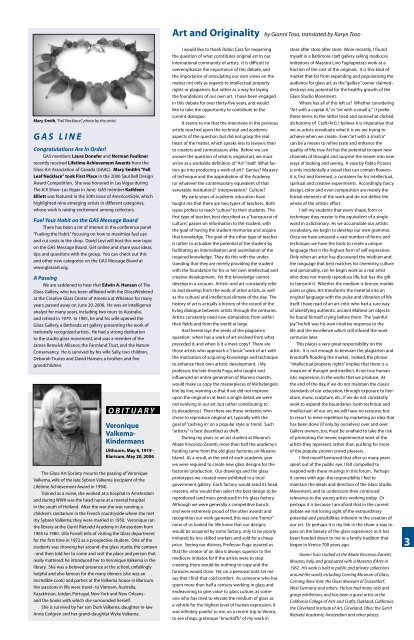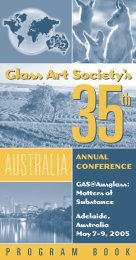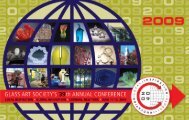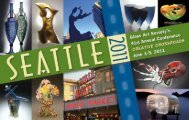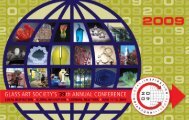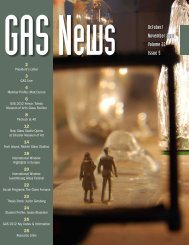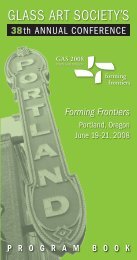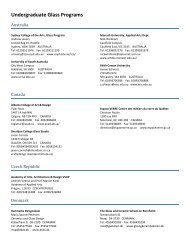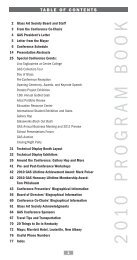GAS News S/O 06 copy - Glass Art Society
GAS News S/O 06 copy - Glass Art Society
GAS News S/O 06 copy - Glass Art Society
Create successful ePaper yourself
Turn your PDF publications into a flip-book with our unique Google optimized e-Paper software.
<strong>Art</strong> and Originality by Gianni Toso, translated by Karyn Toso<br />
Mary Smith,“Fall Necklace”, photo by the artist.<br />
<strong>GAS</strong><br />
LINE<br />
Congratulations Are In Order!<br />
<strong>GAS</strong> members Laura Donefer and Norman Faulkner<br />
recently received Lifetime Achievement Awards from the<br />
<strong>Glass</strong> <strong>Art</strong> Association of Canada (GAAC). Mary Smith’s “Fall<br />
Leaf Necklace” took First Place in the 20<strong>06</strong> Saul Bell Design<br />
Award Competition. She was honored in Las Vegas during<br />
The JCK Show–Las Vegas in June. <strong>GAS</strong> member Kathleen<br />
Elliott was featured in the 50th issue of AmericanStyle, which<br />
highlighted nine emerging artists in different categories,<br />
whose work is raising excitement among collectors.<br />
Fuel Your Habit on the <strong>GAS</strong> Message Board<br />
There has been a lot of interest in the conference panel<br />
“Fueling the Habit,” focusing on how to maximize fuel use<br />
and cut costs in the shop. David Levi will host this new topic<br />
on the <strong>GAS</strong> Message Board. Get online and share your ideas,<br />
tips and questions with the group. You can check out this<br />
and other new categories on the <strong>GAS</strong> Message Board at<br />
www.glassart.org.<br />
A Passing<br />
We are saddened to hear that Edwin A. Hansen of The<br />
<strong>Glass</strong> Gallery, who has been affiliated with the <strong>Glass</strong>Weekend<br />
at the Creative <strong>Glass</strong> Center of America at Wheaton for many<br />
years, passed away on June 20, 20<strong>06</strong>. He was an intelligence<br />
analyst for many years, including two tours to Australia,<br />
and retired in 1979. In 1981, he and his wife opened the<br />
<strong>Glass</strong> Gallery, a Bethesda art gallery presenting the work of<br />
nationally recognized artists. He had a strong dedication<br />
to the studio glass movement, and was a member of the<br />
James Renwick Alliance, the Farmland Trust, and the Nature<br />
Conservancy. He is survived by his wife Sally, two children,<br />
Deborah Trunzo and David Hansen; a brother; and five<br />
grandchildren.<br />
OBITUARY<br />
Veronique<br />
Valkema-<br />
Kindermans<br />
Uithoorn, May 6, 1919 -<br />
Blaricum, May 20, 20<strong>06</strong><br />
The <strong>Glass</strong> <strong>Art</strong> <strong>Society</strong> mourns the passing of Veronique<br />
Valkema, wife of the late Sybren Valkema (recipient of the<br />
Lifetime Achievement Award in 1994).<br />
Trained as a nurse, she worked at a hospital in Amsterdam<br />
and during WWII was the head nurse at a mental hospital<br />
in the south of Holland. After the war she was running a<br />
children’s sanitarium in the French countryside where she met<br />
my Sybren Valkema; they were married in 1950. Veronique ran<br />
the library at the Gerrit Rietveld Academy in Amsterdam from<br />
1965 to 1980. Ulla Forsell tells of visiting the <strong>Glass</strong> department<br />
for the first time in 1972 as a prospective student. One of the<br />
students was showing her around–the glass studio, the canteen<br />
–and then told her to come and visit the place and person that<br />
really mattered: he introduced her to Veronique Valkema in the<br />
library. She was a beloved presence at the school, unfailingly<br />
helpful and also famous for the many dinners (she was an<br />
incredible cook) and parties at the Valkema house in Blaricum.<br />
Her passions in life were travel–to Vietnam, Australia,<br />
Kazakhstan, Jordan, Portugal, New York and New Orleans–<br />
and the books with which she surrounded herself.<br />
She is survived by her son Durk Valkema, daughter-in-law<br />
Anna Carlgren and her grand-daughter Wyke Valkema.<br />
I would like to thank Robin Cass for reopening<br />
the question of what constitutes original art to our<br />
international community of artists. It is difficult to<br />
overemphasize the importance of this debate, and<br />
the importance of articulating our own views on the<br />
matter not only as regards to intellectual property<br />
rights or plagiarism, but rather as a way for laying<br />
the foundations of our own art. I have been engaged<br />
in this debate for over thirty-five years, and would<br />
like to take the opportunity to contribute to the<br />
current dialogue.<br />
It seems to me that the interviews in the previous<br />
article touched upon the technical and academic<br />
aspects of the question, but did not grasp the real<br />
heart of the matter, which speaks less to lawyers than<br />
to creators and connoisseurs alike. Before we can<br />
answer the question of what is original art, we must<br />
arrive at a workable definition of “<strong>Art</strong>” itself. What factors<br />
go into producing a work of art? Genius? Mastery<br />
of technique and the approbation of the Academy<br />
(or whatever the contemporary equivalent of that<br />
venerable institution)? Interpretation? Culture?<br />
My early years of academic education have<br />
taught me that there are two types of teachers. Both<br />
types profess to teach “culture” to their students. The<br />
first type of teacher, best described as a “bureaucrat of<br />
culture,” passes on information to the student, with<br />
the goal of having the student memorize and acquire<br />
that knowledge. The goal of the other type of teacher<br />
is rather to actualize the potential of the student by<br />
facilitating an internalization and assimilation of the<br />
required knowledge. They do this with the understanding<br />
that they are merely providing the student<br />
with the foundation for his or her own intellectual and<br />
creative development. Yet this knowledge cannot<br />
develop in a vacuum. <strong>Art</strong>ists–and art–constantly refer<br />
to and develop from the work of other artists, as well<br />
as the cultural and intellectual climate of the day. The<br />
history of art is actually a history of the record of the<br />
living dialogue between artists through the centuries.<br />
<strong>Art</strong>ists constantly need new stimulation, from within<br />
their fields and from the world at large.<br />
And herein lays the seeds of the plagiarism<br />
question: when has a work of art evolved from what<br />
preceded it, and when is it a mere <strong>copy</strong>? There are<br />
those artists who approach a “classic” work of art with<br />
the motivation of acquiring knowledge and technique<br />
to enhance their own artistic development. (My<br />
professor, the late Anzolo Fuga, who taught and<br />
influenced an entire generation of Murano maestri,<br />
would make us <strong>copy</strong> the masterpieces of Michelangelo<br />
line by line, warning us that if we did not improve<br />
upon the original in at least a single detail, we were<br />
not evolving in our art, but rather contributing to<br />
its decadence.) Then there are those imitators who<br />
chose to reproduce original art, typically with the<br />
goal of “cashing in” on a popular style or trend. Such<br />
“artistry” is best described as theft.<br />
During my years as an art student at Murano’s<br />
Abate Vincenzo Zanetti, more than half the academy’s<br />
funding came from the old glass factories on Murano<br />
Island. As a result, at the end of each academic year<br />
we were required to create new glass designs for the<br />
factories’ production. Our drawings and the glass<br />
prototypes we created were exhibited in a local<br />
government gallery. Each factory would send its head<br />
maestro, who would then select the best design to be<br />
reproduced (and mass produced) in his glass factory.<br />
Although we were generally a competitive bunch,<br />
and were extremely proud of the other awards and<br />
recognition our work garnered, this was one “honor”<br />
none of us looked for. We knew that our designs<br />
would be acquired by some factory, only to be poorly<br />
imitated by less skilled workers and sold for a cheap<br />
price. Seeing our distress, Professor Fuga assured us<br />
that the creator of an idea is always superior to the<br />
mediocre imitator, for if the artists were to stop<br />
creating, there would be nothing to <strong>copy</strong> and the<br />
furnaces would close. Yet, on a personal note, let me<br />
say that I find that cold comfort. As someone who has<br />
spent more than half a century working in glass and<br />
endeavoring to give value to glass culture, as someone<br />
who has tried to elevate the medium of glass as<br />
a vehicle for the highest level of human expression, it<br />
was infinitely painful to me, on a recent trip to Venice,<br />
to see cheap, grotesque “knockoffs” of my work in<br />
store after store after store. More recently, I found<br />
myself in a Baltimore craft gallery selling mediocre<br />
imitations of Maestro Lino Tagliapietra’s work at a<br />
fraction of the cost of the originals. It is this kind of<br />
market that-far from expanding and popularizing the<br />
audience for glass art, as the “gallery” owner claimed–<br />
destroys any potential for the healthy growth of the<br />
<strong>Glass</strong> Studio Movement.<br />
Where has all of this left us? Whether considering<br />
“<strong>Art</strong> with a capital A,” or “art with a small a,” (I prefer<br />
these terms to the rather tired and somewhat clichéd<br />
dichotomy of Craft/<strong>Art</strong>), I believe it is imperative that<br />
we as artists reevaluate what it is we are trying to<br />
achieve when we create. Even “art with a small a”<br />
can be a means to refine taste and enhance the<br />
quality of life; true <strong>Art</strong> has the potential to open new<br />
channels of thought and surprise the viewer into new<br />
ways of looking and seeing. A vase by Pablo Picasso<br />
is only incidentally a vessel that can contain flowers–<br />
it is, first and foremost, a container for his intellectual,<br />
spiritual and creative experiments. Accordingly, fancy<br />
design, color and even composition are merely the<br />
formal elements of the work and do not define the<br />
whole of the artistic effort.<br />
I tell my students that every shape, form or<br />
technique they master is the equivalent of a single<br />
word in a dictionary. As we accumulate our artistic<br />
vocabulary, we begin to develop our own grammar.<br />
Once we have amassed a vast number of forms and<br />
technique, we have the tools to create a unique<br />
language that is the highest form of self expression.<br />
Only when an artist has discovered the medium and<br />
the language that best matches his chemistry, culture<br />
and personality, can he begin work as a real artist<br />
who does not merely reproduce life, but has the gift<br />
to transmit it. Whether the medium is bronze, marble<br />
paint or glass, <strong>Art</strong> transforms the material into an<br />
original language with the pulse and vibration of life<br />
itself. I have read of an art critic who had a sure way<br />
of identifying authentic ancient Maltese art objects:<br />
he found himself crying before them. The “painful<br />
joy” he felt was his own intuitive response to the<br />
life and the excellence which still infused the work<br />
centuries later.<br />
This places a very great responsibility on the<br />
artist. It is not enough to bemoan the plagiarism and<br />
knockoffs flooding the market. Indeed, the phrase<br />
“intellectual property rights” implies that there is a<br />
measure of thought and intellect, if not true humanistic<br />
expression, in the works that we produce. At<br />
the end of the day, if we do not maintain the classic<br />
standards of our education, through exposure to literature,<br />
music, sculpture, etc., if we do not constantly<br />
work to expand the boundaries–both technical and<br />
intellectual–of our art, we will have no recourse but<br />
to resort to mere repetition by marketing an idea that<br />
has been done (if only by ourselves) over and over.<br />
Gallery owners, too, must be unafraid to take the risk<br />
of promoting the newer, experimental work of the<br />
artists they represent, rather than pushing for more<br />
of the popular, proven crowd pleasers.<br />
I find myself bemused that after so many years<br />
spent out of the public eye, I felt compelled to<br />
respond with these musings in this forum. Perhaps<br />
it comes with age–the responsibility I feel to<br />
maintain the ideals and direction of the <strong>Glass</strong> Studio<br />
Movement, and to underscore their continued<br />
relevance to the young artists working today. Or<br />
perhaps it is because I am afraid that in the current<br />
debate we risk losing sight of the extraordinary<br />
potential and possibilities inherent in the creation of<br />
our art. Or perhaps it is my link in the chain: a way to<br />
pass on the beauty of the glass experience as it has<br />
been handed down to me in a family tradition that<br />
began in Venice 700 years ago.<br />
Gianni Toso studied at the Abate Vincenzo Zanetti,<br />
Murano, Italy, and graduated with a Maestro d'<strong>Art</strong>e in<br />
1962. His work is held in public and private collections<br />
around the world, including Corning Museum of <strong>Glass</strong>,<br />
Corning, New York; the <strong>Glass</strong> Museum of Dusseldorf,<br />
West Germany and others. He has had many solo and<br />
group exhibitions, and has been a guest artist at the<br />
California College of <strong>Art</strong>s and Crafts, Oakland, California;<br />
the Cleveland Institute of <strong>Art</strong>, Cleveland, Ohio; the Gerrit<br />
Rietveld Academie, Amsterdam and other places.<br />
3


